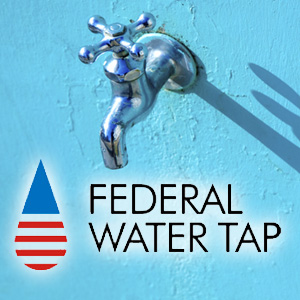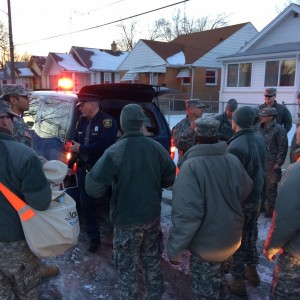Federal Water Tap, January 25: EPA Regional Administrator Resigns over Flint Water Crisis
The Rundown
A change in leadership at EPA Region 5. Obama talks with Flint mayor and directs federal money for water infrastructure improvements. EPA begins internal investigation over Flint response. 2015 was the hottest year on record. Communities get $US 1 billion for climate resiliency. Great Lakes has no surplus water, report says. Republicans call attention to hydropower, while a California Democrat unveils a draft drought bill. California reservoirs are lower than last year. Indian tribes might get more Clean Water Act power, while Obama and Congress tussle over water regulation.
“Some of you know I was in Detroit yesterday, but the day before that, I was meeting with Mayor Weaver, newly elected, in Flint, Michigan, to talk about what has been an inexcusable situation with respect to drinking water there…Our children should not have to be worried about the water that they’re drinking in American cities. That’s not something that we should accept.” — President Barack Obama speaking about Flint at the U.S. Conference of Mayors’ winter meeting in Washington, D.C.
By the Numbers
$US 1 Billion: Funds awarded to states for building infrastructure and housing that is resilient to extreme weather and climate change. (U.S. Department of Housing and Urban Development)
$US 80 million: Water infrastructure funding from the recent Congressional budget that will be directed toward the state of Michigan. (White House)
54.4 degrees Fahrenheit: Average U.S. temperature in 2015, the hottest by 2.4 degrees F. It broke the old record by a record margin. It was also the third-wettest year ever measured in the United States. (NOAA)
36 percent: Share of U.S. coastal waters in which the water quality is rated good, according to the latest National Coastal Condition Assessment (U.S. Environmental Protection Agency)
Studies and Reports
Great Lakes Water Exports
The Great Lakes states and provinces have made “great strides” in protecting the basin’s waters from being exported, according to a report from the binational commission that manages waters shared by Canada and the United States. The report also claims that there is no surplus water to be diverted.
The International Joint Commission applauded the 2008 Great Lakes Compact, which prevents the export of water outside the basin. The only exception is for a community outside the basin is if it is located with a county that straddles the watershed border. Waukesha, Wisconsin is the first community to test that provision. Its application for Great Lakes water is now being evaluated by the basin governors.
Central Valley Project Reservoirs Down
California is getting waves of precipitation, but the main reservoirs for the federal Central Valley Project, which provides irrigation water for some of the nation’s most valuable farmland, are in worst shape than last year.
According to Bureau of Reclamation figures, the main Central Valley Project reservoirs were 20 percent lower on January 22 than on the same date in 2015. Reservoir levels today are 49 percent of the 15-year average. In short, even though it is raining, water is still scarce.
Toxic Release Inventory
The EPA published data on annual release of toxic chemicals from industrial sources. The data is divided by city, state, zip code, and large watershed.
News Briefs
Flint Update
On January 19, President Obama met with Flint Mayor Karen Weaver on his way to Detroit. White House Deputy Press Secretary Eric Schultz said that the president came away from the meeting “determined to resolve the situation as fast as humanly possible.”
Obama named Dr. Nicole Lurie, assistant secretary at the Department of Health and Human Services, to coordinate the federal response in Flint. Numerous federal agencies are on the ground: FEMA is distributing bottled water and filters, CDC is providing technical assistance on health matters, Housing and Urban Development is tracking data on lead pipes.
Meanwhile, EPA Region 5 Administrator Susan Hedman will resign on February 1 over the agency’s handling of the Flint crisis. And Michigan Governor Rick Snyder will likely be called to testify before Congress about the state’s response.
Also, the EPA Office of Inspector General will begin an internal investigation of the agency’s response to Flint’s lead contamination.
Hydropower Battle
Energy takes the stage in Congress this week. The Senate will likely begin debating on Tuesday the Energy Policy Modernization Act, which takes aim at a number of issues that are politically divisive on Capitol Hill: coal leasing and energy exports, to name two.
The bill also seeks to boost hydropower production. In a New York Times opinion piece published last week, Lisa Murkowski (R-AK), one of the bill’s authors, argued that more attention needs to be directed at increasing hydropower generation at existing dams. Green groups are wary that Congress will loosen permitting standards.
California Drought Bill
Sen. Dianne Feinstein (D-CA) published a draft California drought bill. It includes assistance for communities with dry wells, $US 600 million for water storage projects, $US 350 million for water recycling projects, $US 450 million for desalination projects, changes to reservoir operations, and a number of feasibility studies. The bill also allows as much water to be pumped south of the Sacramento-San Joaquin Delta as is legally possible.
Clean Water Act for Tribes
The EPA is developing a rule to allow Indian tribes, much like states, to administer Section 303(d) of the Clean Water Act. That section allows states to identify polluted waters and set maximum pollution levels, called TMDLs.
Public comments are being accepted through March 21. Submit online at www.regulations.gov using docket number EPA-HQ-OW-2014-0622.
Clean Water Rule Continues to Rankle Congress
President Obama vetoed a Senate resolution that would have blocked the EPA’s Clean Water Rule, which defines the scope of the Clean Water Act.
Meanwhile, Sen. Jim Inhofe (R-OK) sent a letter to the U.S. Justice Department calling for an investigation over the EPA’s use of social media to promote the Clean Water rule, also known as the Waters of the United States rule.
Last month, the Government Accountability Office found that the EPA broke the law when it used a Twitter feature called a Thunderclap to promote the rule.
On the Radar
Pipeline Damage from Flooding
The federal pipeline regulator issued an advisory to oil and gas pipeline operators, warning them that flooding can cause failures and spills. The last such advisory was issued in 2011.
Chromium-6 Study
The U.S. Geological Survey is collaborating with Pacific Gas and Electric and a California regional water board to assess the prevalence of natural and manmade chromium-6 in groundwater near the town of Hinkley.
Chromium-6 exposure has led to cancer in laboratory animals and is being considered by the EPA for regulation under the Safe Drinking Water Act. Hinkley was made famous by Erin Brockovich, who sued PG&E for polluting the town’s tap water with chromium-6.
Federal Water Tap is a weekly digest spotting trends in U.S. government water policy. To get more water news, follow Circle of Blue on Twitter and sign up for our newsletter.
Brett writes about agriculture, energy, infrastructure, and the politics and economics of water in the United States. He also writes the Federal Water Tap, Circle of Blue’s weekly digest of U.S. government water news. He is the winner of two Society of Environmental Journalists reporting awards, one of the top honors in American environmental journalism: first place for explanatory reporting for a series on septic system pollution in the United States(2016) and third place for beat reporting in a small market (2014). He received the Sierra Club’s Distinguished Service Award in 2018. Brett lives in Seattle, where he hikes the mountains and bakes pies. Contact Brett Walton






Leave a Reply
Want to join the discussion?Feel free to contribute!